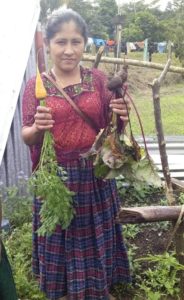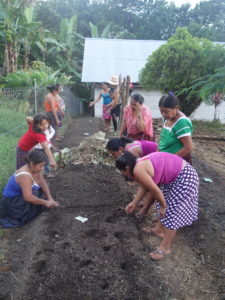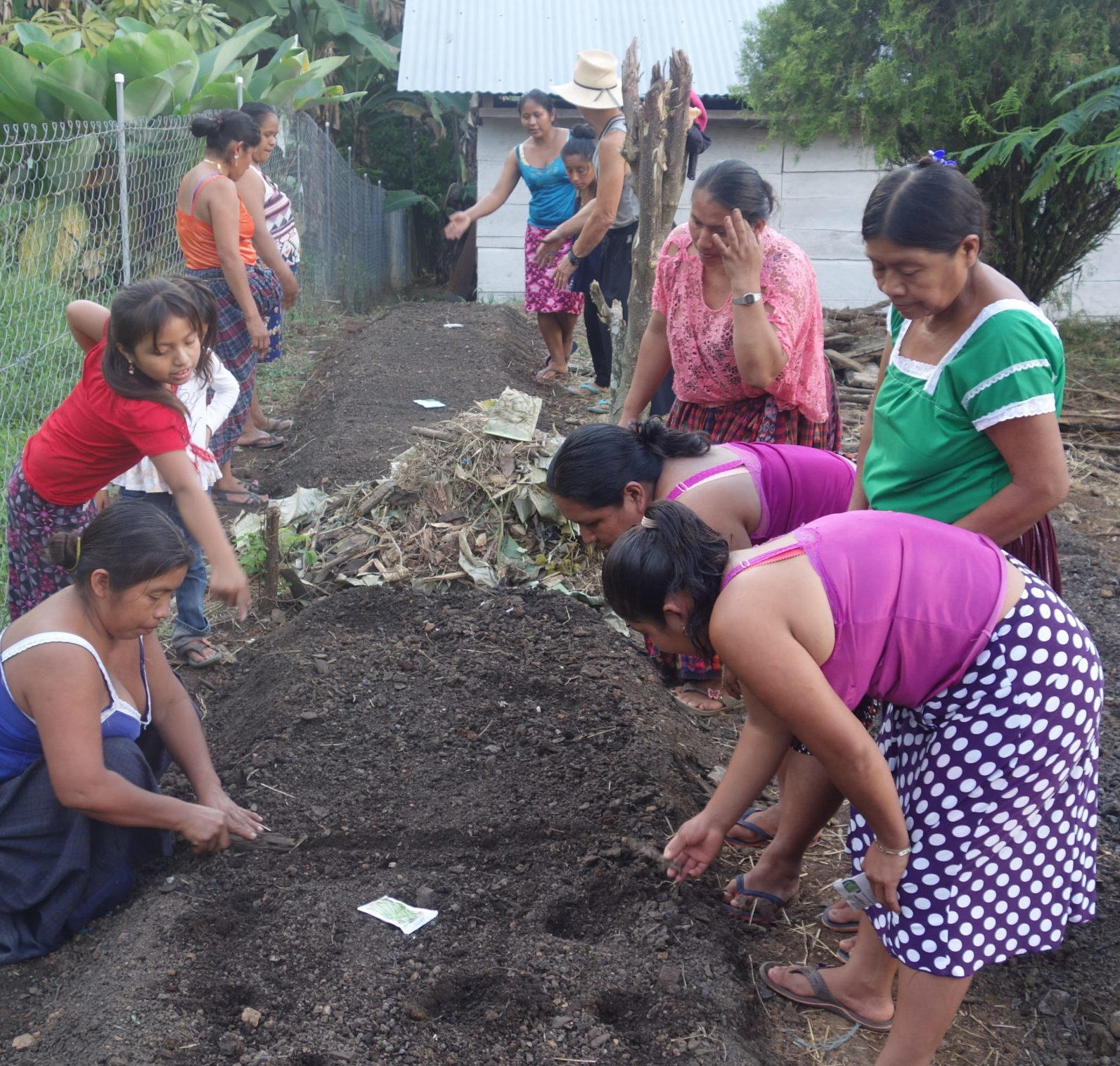A response to Tropic of Chaos
Guest Post by Joan Felice and the Students at El Milagro
Women farmers from Guatemalan mountain villages—many of them schoolgirls—watched Tropic of Chaos and came to know of women farmers from the Lake Chad region of the African continent.
The girls, who attend a boarding school at a distance from their family fields, felt great sympathy for people in the movie who are losing their water, their fields, and their ways of life. They wanted to stand in solidarity with those others, so they wrote messages they’d like to give to their sister-farmers by Lake Chad.
Significantly, this was but another strand in the connections between people of the two continents. The Guatemala girls and their mothers had been given suggestions about how to increase the fertility of their own gardens by a woman who had, decades before, developed those techniques herself with women in Tanzania.
Farming friendship can extend across the ocean, from the African continent to Central America and then back again to Central Africa.
How the Friendships Developed
After the Guatemalan civil war from 1960 to 1996, Lutheran Pastor Horacio Castillo of the Iglesia Luteran Augustina de Guatemala (ILAG) advocated for refugees who had been displaced by the war to be allowed to return and granted land rights. A good many indigenous people returned from exile in Mexico, but the lands they were given were not like the lands they had left.
With the Evangelical Lutheran Church of America, Father Horacio started Caminando Juntos, “walking together,” an organization to allow people from the United States to work as friends with Guatemalan villagers.
Joan Felice, a biology professor from Minnesota, first went to Guatemala with ILAG in 2014. By then, Pastor Castillo’s daughter, Pastora Karen, had become the leader of ILAG. Pastora Karen introduced Joan to women from the village of Cimiento who explained to Joan that they wanted to start a garden.
Although their Mayan ancestors had practiced agriculture and horticulture expertly, these women had not been allowed to grow their own food during their decades in Mexico. When they had returned to Guatemala, they had been assigned to live on lands they were not familiar with. The women wanted to reclaim their heritage by providing food for their community.
Through small grants, the women started a garden in Cimiento. The first year they grew enough to sell some produce. However, the next planting did not thrive. The women asked their Minnesota friends for help. Joan noted that, because the tropical soil was heavy and claylike, it had been depleted by the first crop. She contacted Randee Edmundson, a former Peace Corps volunteer who had worked with people in Tanzania to develop gardens there.
Randee went to Guatemala with ILAG and showed the women and interested men how to compost and build double-dug garden beds that would be nutrient rich and hold water more effectively. On a second visit, she and Joan and the women of Cimiento spent several days building more garden beds. Each woman farmer from the village produced a bag of compost for the beds.
Joan and Randee returned to the US, but the women in Cimiento did not forget them. They sent a picture of one of them them holding a yellow carrot and two purple beets from the beds.

The Young Women’s Responses to the Tropic of Chaos
When Joan saw Tropic of Chaos, she thought of the farmers in Guatemala. Women in the villages did not have access to computers to view the movie, but Joan remembered the girls at El Milagro school.
During their last visit to Guatemala, Joan and Randee had spent several days with young women at the school, teaching about gardening and nutrition. Pastora Karen had founded the school because, in the villages, the schools provide only the first five or six years of education. In the villages, many girls marry in their teens because their options are limited; parents hesitate to send their young daughters away to large cities to continue their studies. After Pastora Karen founded El Milagro in Guatemala City, girls from Cimiento and other villages were able to move there because their parents felt that school to be safe. There, the girls continue their academic and religious studies, developing both leadership and life skills.
Pastora Karen agreed with Joan that the girls might benefit from seeing the video. “The people here should see what can happen if they do not take care of the land they have,” she said. “They also can learn that their situation is not as bad as it is for other people.”
Diego Gil, who teaches sustainability and nutrition weekly at the school, showed the video to the young women during class.
From Guatemalan Women to Women Near Lake Chad
When young women saw the movie, they noticed similarities between that land and theirs. They said, “Rivers and lakes are drying up and there is a lack of water in the summer. There is garbage and contamination in the rivers, streams, and lakes. Trees have been chopped down. The land is no longer fertile.”
They wanted to tell the women living near Lake Chad, “Take care of the few trees you still have and plant more trees. Meet with your neighbors to gather ideas about how to improve where you are living. You must educate your children and cultivate food for yourselves.”
The girls explained what they have learned about farming: “Produce compost. Use it to fertilize the crops and improve the soil. Turn the soil every time you plant. Sow seeds during a suitable season. Get help or advice from those who know the land well.”
The young women went on to explain, “Every region is different in how you cultivate. If foreigners show how to grow things in their country, it is not going to be reproducible in a different country. Foreigners may use different seeds and methods of sowing seeds. They may want to plant seeds that the people do not want to eat. There may be a lack of understanding between the two groups of people. The foreigners may not know what it is like for the people in the new place to use what they harvest or they may not want to participate in organizations that already exist in the area they want to help.”
Clearly, the girls know of problems that can arise when outsiders try to help a community. So how, they were asked, can cooperation be positive? “We are willing to work with foreigners,” most girls said. “But we want to work as a team where both groups learn from each other, sharing and supporting each other.” One girl, however, preferred to work with her family without others because she was concerned about being mocked.
If these girls from Guatemala could go to the Lake Chad region, they said they would want to “help plant trees both in the areas around their houses and near their fields. We would want to organize groups to plant trees together and share any knowledge each group has acquired. We would like to teach the children in the families and learn how to keep the land from turning into sand. Because this is a desert area, we believe the plants will have to be watered every day.”
Since the girls would most likely be staying in their villages, not going to visit Lake Chad, they were asked what they want to do at home. They responded that they “plan not to destroy trees and to plant more.”
“We will make compost and not use chemicals in our fields. We will plant seeds, carefully water the crops, follow good techniques we have learned and be productive with what we have.”
They have plans to expand their efforts. “We want,” they said, “to make a simple greenhouse so that the plants have a cooler place to begin growing.”

-With thanks to Joan Felice for providing this history and for translating the girls’ words from Spanish
